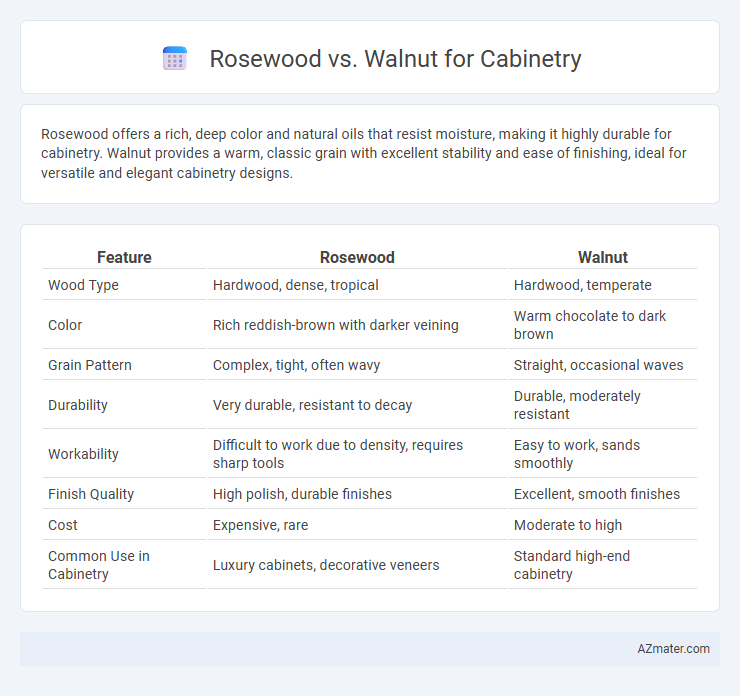Rosewood offers a rich, deep color and natural oils that resist moisture, making it highly durable for cabinetry. Walnut provides a warm, classic grain with excellent stability and ease of finishing, ideal for versatile and elegant cabinetry designs.
Table of Comparison
| Feature | Rosewood | Walnut |
|---|---|---|
| Wood Type | Hardwood, dense, tropical | Hardwood, temperate |
| Color | Rich reddish-brown with darker veining | Warm chocolate to dark brown |
| Grain Pattern | Complex, tight, often wavy | Straight, occasional waves |
| Durability | Very durable, resistant to decay | Durable, moderately resistant |
| Workability | Difficult to work due to density, requires sharp tools | Easy to work, sands smoothly |
| Finish Quality | High polish, durable finishes | Excellent, smooth finishes |
| Cost | Expensive, rare | Moderate to high |
| Common Use in Cabinetry | Luxury cabinets, decorative veneers | Standard high-end cabinetry |
Introduction to Rosewood and Walnut for Cabinetry
Rosewood and walnut are premium hardwoods favored in cabinetry for their durability and rich aesthetic appeal. Rosewood features deep reddish-brown hues with strong grain patterns, offering a luxurious and exotic finish ideal for statement pieces. Walnut provides a warm, chocolate-brown tone with smooth, consistent grain, making it versatile for both traditional and modern cabinetry styles.
Appearance and Color Variations
Rosewood offers a rich, deep reddish-brown hue with striking dark veining, creating a luxurious and exotic appearance for cabinetry. Walnut features a warm, chocolate-brown tone with a more consistent grain pattern, ranging from pale beige to dark brown, lending a classic and elegant look. Both woods provide distinctive aesthetic appeal, but rosewood's bold color variations contrast with walnut's subtle and uniform shades.
Grain Patterns and Texture Comparison
Rosewood features rich, pronounced grain patterns with a combination of dark and light streaks that create a dramatic and luxurious appearance. Walnut displays more uniform and subtle grain patterns with a smooth texture, offering a warm, classic, and refined look for cabinetry. The dense, oily texture of rosewood contrasts with walnut's fine, even pores, making rosewood slightly more durable but also more expensive.
Durability and Hardness
Rosewood exhibits a Janka hardness rating between 1,800 and 2,200, making it one of the hardest and most durable woods suitable for cabinetry, with excellent resistance to wear and impact. Walnut, with a Janka hardness of approximately 1,010, offers moderate durability, making it less resistant to dents and scratches compared to rosewood but still a popular choice for its rich, warm appearance. For high-traffic cabinetry or surfaces requiring superior hardness, rosewood provides enhanced longevity, while walnut balances durability with a classic aesthetic appeal.
Workability and Machining
Rosewood offers excellent workability with its natural oils that provide a smooth finish, but its hardness can pose challenges during machining, requiring sharp tools and slower feed rates. Walnut is easier to machine due to its moderate hardness and consistent grain, making it ideal for intricate cabinetry details and reducing the risk of tear-out. Both woods respond well to sanding and finishing, but walnut's workability typically results in more predictable results during cabinet production.
Cost and Availability
Rosewood cabinetry commands a significantly higher price due to its rarity, limited supply, and exotic appeal, often making it a luxury choice for high-end projects. Walnut is more widely available and moderately priced, providing a balance of durability and aesthetic appeal suited for a variety of budgets. Availability of rosewood is restricted by regulations and sustainability concerns, whereas walnut is sustainably sourced and easier to procure for large-scale cabinetry applications.
Maintenance and Care Requirements
Rosewood cabinetry demands regular oiling to maintain its rich color and prevent drying or cracking, making it higher maintenance compared to walnut. Walnut requires less frequent upkeep, needing occasional cleaning with a gentle wood cleaner and periodic polishing to preserve its smooth finish. Both woods benefit from avoiding excessive moisture and direct sunlight to ensure longevity and maintain their aesthetic appeal.
Environmental Impact and Sustainability
Rosewood, often harvested from tropical rainforests, faces significant environmental concerns due to overharvesting and slow growth rates, leading to habitat loss and biodiversity decline. Walnut, primarily sourced from temperate regions with managed forestry practices, generally offers a more sustainable option thanks to faster growth cycles and certifications like FSC promoting responsible harvesting. Choosing walnut for cabinetry supports lower environmental impact and better sustainability compared to the often endangered rosewood species.
Best Applications for Rosewood and Walnut Cabinets
Rosewood cabinets excel in luxury settings due to their rich, dark hues and natural oily texture, making them ideal for high-end kitchens and custom furniture requiring durability and a striking appearance. Walnut cabinets offer warmth with their fine grain and medium brown color, perfectly suited for traditional and contemporary homes where versatility and a smooth finish are desired. Both woods perform well in cabinetry but rosewood is preferred for statement pieces, while walnut is favored for everyday elegance and robust use.
Final Verdict: Choosing the Right Wood for Your Cabinets
Rosewood offers a rich, dark hue with natural oils that enhance durability and resistance to wear in cabinetry, making it ideal for high-end, luxurious designs. Walnut features a warm, medium-brown tone with a smooth grain, providing versatile strength and elegance suitable for both modern and traditional cabinet styles. The final verdict depends on your aesthetic preference and budget, with rosewood ideal for premium, statement pieces and walnut serving as a cost-effective, timeless choice for durable cabinetry.

Infographic: Rosewood vs Walnut for Cabinetry
 azmater.com
azmater.com